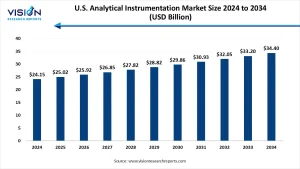The U.S. analytical instrumentation market size was evaluated at around USD 24.15 billion in 2024 and it is projected to hit around USD 34.40 billion by 2034, growing at a CAGR of 3.60% from 2025 to 2034.
Get a Sample@https://www.visionresearchreports.com/report/sample/41742
U.S. Analytical Instrumentation Market Overview
The U.S. analytical instrumentation market plays a pivotal role in supporting industries that demand high accuracy, repeatability, and real-time data analysis. These instruments are essential across sectors such as pharmaceuticals, biotechnology, food safety, environmental monitoring, and materials science. As technological innovation accelerates, analytical tools are becoming smarter, more compact, and increasingly integrated with automation and AI.
Continued demand for quality assurance, regulatory compliance, and research innovation ensures this market remains vital. With increasing investments in R&D and the growing need for advanced testing solutions, analytical instrumentation is evolving from a support tool to a critical enabler of progress in science and industry.
U.S. Analytical Instrumentation Market Growth
The market is projected to grow from USD 24.15 billion in 2024 to USD 34.40 billion by 2034, expanding at a CAGR of 3.60%. This steady growth reflects sustained investment in laboratory infrastructure and quality control processes. Government funding and policies supporting clean energy, pharmaceutical development, and food safety are encouraging the adoption of modern analytical solutions.
Rising demand in the healthcare and life sciences sectors also supports market expansion. The ongoing need for precision diagnostics, vaccine development, and genomic research has led to increased utilization of instruments like mass spectrometers, chromatography systems, and spectroscopy devices. Academic and industrial research labs alike are boosting procurement, further driving market momentum.
What is the U.S. Analytical Instrumentation Market?
The U.S. analytical instrumentation market refers to the industry that designs, manufactures, and supplies tools used to measure, analyze, and evaluate the physical and chemical properties of materials. These instruments are essential for performing laboratory analysis, ensuring quality control, conducting scientific research, and meeting regulatory standards.
Common tools include chromatography systems, spectrometers, microscopes, and mass spectrometers. These instruments support a wide range of sectors including pharmaceuticals, biotechnology, environmental science, food safety, and materials research.
Resilience Post-Pandemic Strengthening the Role of Analytical Instruments
The COVID-19 pandemic was a pivotal moment that highlighted the indispensable role of analytical instrumentation in global health responses. During the crisis, advanced instruments were rapidly deployed for high-throughput testing, genomic sequencing of the virus, and quality assurance in vaccine production. Techniques such as real-time PCR, mass spectrometry, and immunoassays became central to diagnostics and monitoring efforts.
This period also revealed the importance of agility in laboratory environments. Many facilities adapted by upgrading or expanding their analytical capabilities, which now sets a precedent for future pandemic preparedness. As a result, there is sustained momentum in investing in robust, flexible, and digitally connected instrumentation systems that can respond quickly to emerging health threats. This resilience and adaptability will continue to drive innovation and reinforce the U.S. market’s commitment to public health and biomedical research.
U.S. Analytical Instrumentation Market Dynamics
Driven
- Growing focus on research in pharmaceuticals and biotechnology
- Increasing regulatory requirements for product testing and quality validation
- Demand for real-time and highly sensitive analysis in clinical diagnostics
Opportunities
- Rising investments in healthcare infrastructure and precision medicine
- Emergence of nanotechnology and advanced materials science
- Expansion of environmental monitoring to combat pollution and climate change
Challenges
- High cost of sophisticated analytical instruments
- Complex installation and maintenance needs
- Shortage of skilled professionals to operate advanced systems
Application in Market
- Pharmaceuticals and Biotechnology: Used for drug development, quality control, and ensuring regulatory compliance through techniques like HPLC and mass spectrometry.
- Environmental Testing: Helps detect pollutants in air, water, and soil using tools like gas chromatography and spectroscopy for regulatory monitoring.
- Food and Beverage Industry: Ensures food safety, detects contaminants, and maintains quality with instruments for nutritional and allergen analysis.
- Chemical and Petrochemical: Monitors production processes, checks purity, and enhances safety using gas analyzers and thermal analysis tools.
- Academic and Government Research: Supports scientific research and innovation in universities and labs through advanced chemical and physical analysis.
Case Study Analytical Instruments in Drug Development
A U.S.-based pharmaceutical company adopted next-generation high-performance liquid chromatography (HPLC) and gas chromatography-mass spectrometry (GC-MS) systems during the development of a new oncology drug. By integrating AI-powered data analytics with their instrumentation setup, they reduced the drug discovery timeline by nearly 20%, enhanced reproducibility, and ensured full compliance with FDA regulations. This demonstrates how strategic instrumentation adoption can accelerate innovation while ensuring quality and compliance.
U.S. Analytical Instrumentation Market Trends
- Integration with AI and Machine Learning: Analytical systems are increasingly incorporating AI to automate data interpretation, reduce human error, and improve decision-making speed.
- Rise of Portable and Handheld Devices: On-site testing and fieldwork are pushing the development of compact and mobile instrumentation, particularly in environmental and food safety sectors.
- Emphasis on Green Chemistry and Sustainability: Analytical labs are focusing on eco-friendly processes, encouraging manufacturers to develop low-energy instruments and minimize hazardous waste.
- Cloud-Enabled Analytical Platforms: Cloud connectivity is allowing remote monitoring, real-time collaboration, and centralized data storage, transforming traditional workflows.
Read More:https://www.heathcareinsights.com/life-science-tools-market/
Top Companies in U.S. Analytical Instrumentation Market
- Thermo Fisher Scientific Inc.
- Agilent Technologies, Inc.
- PerkinElmer, Inc.
- Waters Corporation
- Danaher Corporation
- Bruker Corporation
- Shimadzu Scientific Instruments
- Bio-Rad Laboratories, Inc.
- Merck KGaA (MilliporeSigma)
- Illumina, Inc.
U.S. Analytical Instrumentation Market Segments
- Chromatography
- Spectroscopy
- Mass Spectrometry
- Molecular Analysis
- Elemental Analysis
- Thermal Analysis
- Surface Analysis
- Others
Future Outlook
As industries strive for faster, more accurate, and environmentally conscious testing, the future of analytical instrumentation in the U.S. is set for transformation. The rise of automation, digital twin technologies, and quantum analysis tools will redefine precision measurement. The integration of smart labs and robotics will further enhance capabilities, making the market increasingly indispensable across applications.
Buy this Premium Research Report@https://www.visionresearchreports.com/report/checkout/41742
You can place an order or ask any questions, please feel free to contact
sales@visionresearchreports.com| +1 650-460-3308